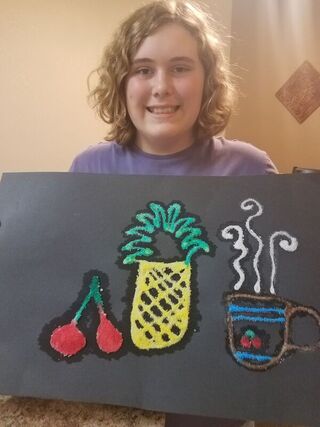 This week’s STEAM Star is Leah Welker, an 8th grader at Quincy Junior High School. She is trying out one of most popular STEAM projects, salt painting. Thank you Leah for creating this fun activity for us! This fun STEAM project from busymommedia.com uses the power of salt absorption to create a unique work of art. In the process of creating a salt painting, you’ll see first hand how salt effectively absorbs moisture from the environment. Before starting the project, discuss how salt is used not just to favor our food but also prevents food from spoiling. Salt absorbs moisture from its surroundings helping to inhibit the growth of bacteria in foods. With that in mind, observe how quickly and effectively salt absorbs the watercolors. Material List
Baking sheet Black construction paper Table salt Glue Watercolors Pencil Paint Brushes Instructions: 1. Assemble your supplies 2. Use a pencil to trace your design onto construction paper 3. Outline your design with a thick line of glue and put it on the baking sheet 4. Sprinkle salt onto the glue (completely covering the glue) 5. Gently shake off the excess salt from the painting. An adult may want to assist a young scientist with this portion of the project. 6. Use a paint brush to slowly drip the watercolor mixture onto the salt. 7. Allow your painting to dry for at least a couple of hours. Try This Out! Now that you have mastered this heart shaped STEAM project, try creating words and other fun designs in future salt paintings. You can even create fun sea creatures, such as jellyfish, or a yummy ice cream cone. In addition, try using sugar or other absorbent compounds instead of salt and then compare the results to see which ingredient works best and how they differ in results. The Science Behind the Salt This STEAM project is a great illustration of the scientific properties of water and salt. As the salt and the color mixture meet, the salt begins to absorb the liquid. This chemical process adds the color from the liquid mixture to the salt and causes the salt to dissolve. When the water evaporates from the mixture, the color remains and the salt crystallizes. Once the salt crystallizes, the texture of the painting is changed.
0 Comments
Leave a Reply. |
Archives
June 2024
Categories |

 RSS Feed
RSS Feed
